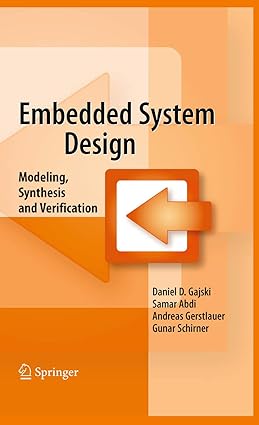White Paper
Embedded System Design: Modeling, Synthesis, and Verification
Authors:
-
Tapas Shome , ias-research.com
-
Boris Reisig, ias-research.com
Abstract
Embedded systems, ubiquitous in modern devices, require efficient design methodologies to meet demanding performance, power, and cost constraints. This white paper provides a comprehensive overview of embedded system design, focusing on the critical aspects of modeling, synthesis, and verification. We explore various techniques and tools used in each phase of the design process, accompanied by illustrative examples to enhance understanding.
Introduction
Embedded systems, characterized by their integration of hardware and software components, are integral to a wide range of applications, from consumer electronics to industrial control. The design of embedded systems presents unique challenges due to their stringent requirements for performance, power consumption, and cost-effectiveness. To address these challenges, efficient design methodologies are essential.
Modeling Embedded Systems
-
Behavioral Modeling: We discuss the use of behavioral modeling languages, such as SystemC, VHDL, and Verilog, to capture the functional behavior of embedded systems at a high level of abstraction.
-
Architectural Modeling: We explore techniques for modeling the architectural structure of embedded systems, including the interconnection of components and their interactions.
-
Hardware-Software Co-Simulation: We discuss the integration of hardware and software models to enable early system-level analysis and verification.
Synthesis of Embedded Systems
-
High-Level Synthesis (HLS): We delve into HLS tools and techniques that can automatically generate hardware implementations from high-level behavioral descriptions.
-
Logic Synthesis: We discuss the process of transforming a high-level design into a gate-level netlist, optimizing for area, performance, and power consumption.
-
Floorplanning and Placement: We explore techniques for arranging components on a physical chip to minimize wire length and improve performance.
-
Routing: We discuss the process of connecting components together using wires, considering factors such as congestion and timing constraints.
Verification of Embedded Systems
-
Functional Verification: We discuss techniques for verifying the correctness of the embedded system's functionality, including simulation, formal verification, and hardware emulation.
-
Performance Verification: We explore methods for evaluating the system's performance, such as timing analysis and power estimation.
-
Hardware-Software Co-Verification: We discuss the importance of verifying the interaction between hardware and software components to ensure correct system behavior.
Use Cases
-
Case Study 1: Automotive ECU Design: We present a case study of designing an automotive Electronic Control Unit (ECU) using embedded system design methodologies. We discuss the modeling, synthesis, and verification challenges specific to automotive applications.
-
Case Study 2: IoT Device Development: We explore the design of Internet of Things (IoT) devices, emphasizing the importance of low-power consumption and security. We discuss how embedded system design methodologies can address these challenges.
-
Case Study 3: Real-Time Embedded Systems: We discuss the design of real-time embedded systems, such as those used in industrial control or medical devices. We highlight the critical requirements for meeting strict timing constraints and ensuring system reliability.
Conclusion
Embedded system design presents unique challenges due to the stringent requirements for performance, power, and cost-effectiveness. By employing effective modeling, synthesis, and verification methodologies, designers can address these challenges and develop high-quality embedded systems. This white paper has provided a comprehensive overview of these critical aspects, equipping readers with the knowledge to effectively design and implement embedded systems.
References
[List of relevant references, including books, articles, and online resources]
Appendix
[Optional: Include additional information, such as code examples, diagrams, or supplementary materials]
References
Books:
-
Embedded Systems Design: An Introduction to Programming and Computer Architecture by David Harris and Sarah Harris. Morgan Kaufmann, 2021.
-
Digital Design: A Systems Approach by John F. Wakerly. Prentice Hall, 2017.
-
SystemC: The Next Generation of System-Level Modeling by Janick Bergeret and Jean-Pierre David. Kluwer Academic Publishers, 2005.
-
High-Level Synthesis: A Practical Approach by David L. Black. Morgan Kaufmann, 2008.
-
Hardware-Software Codesign by Wayne Wolf. Morgan Kaufmann, 2011.
-
Formal Verification of Hardware and Software Systems by Daniel Kroening and Ofer Strichman. Springer, 2008.
-
Advanced SystemC Verification by Andreas Gerstlauer. Springer, 2012.
Online Resources:
-
Accellera SystemC Website: https://systemc.org/
-
SystemC Community Forums: https://forums.accellera.org/forum/9-systemc/
-
SystemC Tutorials and Examples: https://www.accellera.org/resources/videos/systemc-tutorial-2017
-
SystemC Research Papers and Publications: https://scholar.google.com/scholar
-
SystemC-Based Tools and Software: https://www.accellera.org/downloads/standards/systemc
Additional References:
-
Specific research papers, articles, or case studies related to embedded system design, modeling, synthesis, and verification can be found through academic databases, such as IEEE Xplore, ACM Digital Library, and Google Scholar.
Note: The specific references you may need to cite will depend on the content and focus of your work. Be sure to carefully review the guidelines of your assignment or publication to ensure that you include all necessary references. contact ias-research.com



